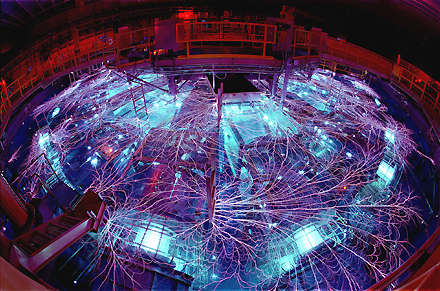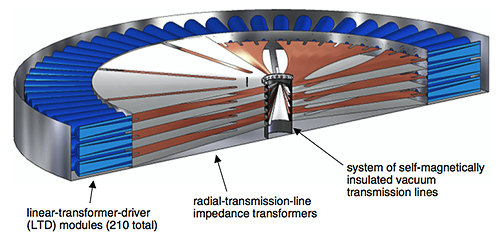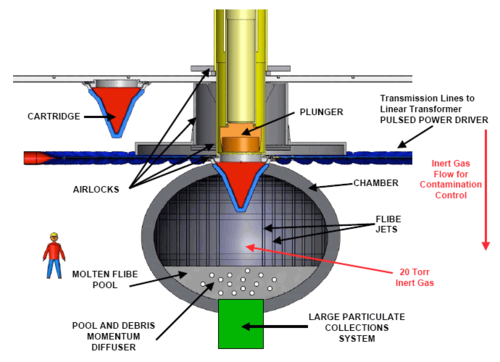Z machine
From Wikipedia, the free encyclopedia
- This article is about the X-ray generator. For the Infocom virtual machine, see Z-machine.

The Z machine is the largest X-ray generator in the world and is designed to test materials in conditions of extreme temperature and pressure. Operated by Sandia National Laboratories, it gathers data to aid in computer modeling of nuclear weapons. The Z machine is located at Sandia's main site in Albuquerque, New Mexico.
Contents |
[edit] Operation overview
The Z machine fires a very powerful electrical discharge (several tens million-ampere for less than 100 nanoseconds) into an array of thin, parallel tungsten wires called a liner. The high electrical current vaporizes the wires, transformed into a cylindrical plasma curtain. Simultaneously, the current density induces a powerful magnetic field and their combination creates Lorentz forces which radially compress the plasma into a z-pinch process. The imploding plasma produces a high temperature and an X-ray pulse which can create a shock wave in a target structure. The target structure is placed in a cavity inside the wires called a hohlraum. The powerful fluctuation in the magnetic field (an "electromagnetic pulse") also generates electric current in all of the metallic objects in the room (see picture at upper right). The vertical cylinder's axis is conventionally termed the z-axis, hence the name "Z machine".
Originally designed to supply 50 terawatts of power in one fast pulse, technological advances resulted in an increased output of 290 terawatts, enough to study nuclear fusion. Z releases 80 times the world's electrical power output for a few billionths of a second; however, only a moderate amount of energy is consumed in each test (roughly equal to the electrical energy consumed by 100 U.S households in two minutes[quantify]). Marx generators are slowly charged with energy prior to firing.
Sandia announced the fusing of deuterium in the Z machine on April 7, 2003.[1] This application could result in an efficient method to ignite a nuclear fusion reaction starting from a small capsule of deuterium. Unfortunately many technical difficulties Ś for instance the small quantity of deuterium that can be contained in the hohlraum and the practical impossibility to transfer the compressed capsule to a larger nuclear fuel reservoir Ś prevent the machine to be used this way, for the moment.
Besides being used as an X-ray generator, the Z machine propelled small plates at 34 kilometres a second, faster than the 30 kilometres per second that Earth travels in its orbit around the Sun, and three times Earth's escape velocity.[2] It also successfully created a special, hyperdense "hot ice" known as ice VII, by quickly compressing water to pressures of 70,000 to 120,000 atmospheres.[3]
At the end of 2005, the Z machine produced plasmas with announced temperatures in excess of 2 billion kelvins (2 GK, 2?109 K) or 3.6 billion ░F, even reaching a peak at 3.7 billion K or 6.6 billion ░F.[4][5][6] It was achieved in part by replacing the tungsten wires by thicker steel wires. This temperature, which enables a 10% to 15% efficiency in converting electrical energy to soft x-rays, was much higher than anticipated (3 to 4 times the kinetic energy of the incoming wires on axis). Thus far, it is currently the highest man-made temperature ever achieved according to The Guinness Book Of Records. The origin of this extra energy still remains unexplained, but it has been theorized that small-scale MHD turbulence and viscous damping would convert magnetic energy into thermal energy of the ions, which then would transfer their energy to the electrons through collisions.[5][6]
[edit] Prospects
The ultra high temperatures reached in 2005 (2.66 to 3.7 billion Kelvin) are greatly higher than those required for the classical hydrogen, deuterium and tritium fusion envisaged hitherto. They could allow in theory, if not in practice, the fusion of light hydrogen atoms with heavier atoms such as lithium or boron. These two possible fusion reactions do not produce neutrons thus no radioactivity nor nuclear waste, so they open for the first time the possibility of a man-made clean aneutronic fusion. But it could also represent a potential nuclear proliferation problem, because pure fusion weapons could be made if the little fission A-bomb used classically for ignition of H-bombs were replaced by a Z pinch detonator, fed with a compact pulsed power generator fast enough (a disc generator for example).[7]
A $60 million (raised to $90 million) retrofit program called ZR (Z Refurbished) was announced in 2004 to increase the power by 50%. The Z machine was dismantled in July of 2006 for this upgrade, including the installation of newly designed hardware and components and more powerful Marx generators. The de-ionized water section of the machine has been reduced to about half its old size while the oil section has been expanded significantly in order to house larger intermediate storage lines (i-stores) and new laser towers, which used to sit in the water section. The refurbishment was completed in October of 2007.[8] The newer Z machine can now shoot 27 million amperes instead of 18 million amperes previously, still in 95 nanosecond . The radiated power has been raised to 350 terawatts and the X-ray energy output to 2.7 megajoules. However the maximum temperature the new version could reach with the same record holder stainless steel wire-array liner used in 2005 is not known yet.
Sandia's roadmap includes another future Z machine version called ZN (Z Neutron) to test higher yields in fusion power and automation systems. ZN is planned to give between 20 and 30 MJ of hydrogen fusion power with a shot per hour thanks to Russian linear transformer drivers (LTD) replacing the current Marx generators.[9] After 8 to 10 years of operation, ZN would become a transmutation pilot plant capable of a fusion shot every 100 seconds.[10]
The next step planned would be the Z-IFE (Z-inertial fusion energy) test facility, the first true z-pinch driven prototype fusion power plant. It is suggested it would integrate Sandia's latest designs using LTDs. Sandia labs recently proposed a conceptual 1 petawatt (1015 watts) LTD Z-pinch power plant, where the electric discharge would reach 70 million amperes.[11]
One should however note all these announced fusion systems make use of the X-ray radiation to heat a hohlraum in order to indirectly ignite fusion reaction of isotopes of hydrogen. The unexpected ultra high temperature achieved recently is not taken into account yet for any possible use of direct aneutronic fusion reactions (p¢7Li or p¢11B) which, if proven practicable, would imply reconsidering some proposed designs.
[edit] The Sandia Z-IFE project
- Further information: Inertial fusion power plant
The Sandia Laboratories Z-IFE project[12] is based upon a repetitive process ensuring the implosion of a fuel capsule every 10 seconds, planned to produce around 3 GJ (3?109 joules) of fusion energy; the technique used is a z-pinch inertial confinement.
The figure represents a cutaway of a reactor as proposed by Sandia; a production plant would be made up of several such reactors (12 in the ZP-3 demonstration plant, of which 10 would operate simultaneously). Using the analogy previously introduced, such a design is equivalent to the multiple cylinders of a gasoline engine.
Without going into technical details (further information is available in the links at the bottom of the article), it is possible to distinguish the following elements:
- The red triangular device ("cartridge") corresponds to a cartridge formed by the fuel microcapsule, the "wires array" and the power transmission device; cartridges are transported to the top of the reactor chamber by an automatic loading mechanism, the rail which can be seen in the upper part of the image being a part of it.
- The thick horizontal blue line, tangent to the reaction chamber, is the power transmission line which carries an extremely short and powerful electrical pulse to the "wires array" device[13] necessary to the z-pinch process;
- The reactor chamber is filled by an inert gas under low pressure (20 Torr or 2.6 kPa, the normal atmospheric pressure being 760 Torr or 101 kPa).
- The internal blanket of the reactor chamber is a thick-liquid wall of flibe (liquid mixture of lithium fluoride and beryllium difluoride) intended to protect the external wall, to absorb the fusion neutron energy, and to produce tritium.[14]
- Finally, the system is intended to recycle the cartridges' debris, collected by the flibe "pool", after their destruction at the time of the fusion.
[edit] Notes and references
- ^ Z produces fusion neutrons, Sandia scientists confirm, Sandia's press release (April 7, 2003).
- ^ Z fires objects faster than Earth moves through space, Sandia's press release (June 6, 2005).
- ^ Ice created in nanoseconds by SandiaÆs Z machine, Sandia's press release (March 15, 2007).
- ^ SandiaÆs Z machine exceeds two billion degrees Kelvin, Sandia's press release (March 8, 2006).
- ^ a b Abstract of Malcolm Haines' paper published in Physical Review Letters 7, Vol.96 (February 24, 2006).
- ^ a b Analysis of Malcolm Haines' paper by Jean-Pierre Petit (June 25, 2006).
- ^ The Question of Pure Fusion Explosions Under the CTB, Science & Global Security, Vol.7, Appendix D (1998).
- ^ Successful 'shots' signal re-opening of Sandia's giant Z accelerator, Sandia's press release (17 October, 2007).
- ^ Rapid-fire pulse brings SandiaÆs Z method closer to goal of developing high-yield fusion reactor, Sandia's press release (April 27 , 2007).
- ^ Z-Inertial Fusion Energy: Power Plant Final Report FY 2006, Sandia Report SAND2006-7148 (October 2006).
- ^ W.A. Stygar et al., Architecture of petawatt-class z-pinch accelerators (October 2007).
- ^ An introduction to the Z-IFE project may be found here.
- ^ For further details, see Pulsed power article.
- ^ Tritium is produced when neutrons created during the fusion irradiates flibe lithium.
[edit] See also
- Sandia National Laboratories
- Fusion power
- Stockpile stewardship
- Pulsed power
- Inertial fusion power plant
[edit] External links
|
| |||||||||||||
|---|---|---|---|---|---|---|---|---|---|---|---|---|---|
| Magnetic |
| ||||||||||||
| Inertial |
| ||||||||||||
| International Fusion Materials Irradiation Facility | |||||||||||||



